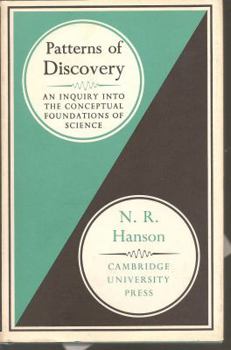Patterns of Discovery: An Inquiry into the Conceptual Foundations of Science
Select Format
Select Condition 
Book Overview
Philosophers of science have given considerable attention to the logic of completed scientific systems. In this 1958 book, Professor Hanson turns to an equally important but comparatively neglected... This description may be from another edition of this product.
Format:Hardcover
Language:English
ISBN:0521051975
ISBN13:9780521051972
Release Date:January 1958
Publisher:Cambridge University Press
Length:252 Pages
Weight:1.10 lbs.
Dimensions:0.8" x 5.7" x 8.3"
Customer Reviews
1 rating
Seminal Monograph by a Pioneering Pragmatist
Published by Thriftbooks.com User , 19 years ago
A cornerstone of positivism is that scientific observation language is independent of scientific theory language, such that in even the most revolutionary developments, only theory language is revised and observational description remains unchanged. Hanson is one of the early critics of positivism and a pioneer of the contemporary pragmatism, which prevails in academic philosophy of science today. His more memorable and remembered refrains are that "there is more to seeing than meets the eye" and that scientific observation is "theory-laden". Hanson was not the first to recognize the conceptual component in observation. Heisenberg reported that in 1926 Einstein had told him that it is the theory that decides what the physicist can observe. And in 1959 Popper wrote in his book, Logic of Scientific Discovery that scientific observation is always in the light of theories, and in his book Objective Knowledge (1972) Popper said that observation is "theory-impregnated". But Hanson furthermore saw that the conceptual component in observation has historically operated as an impediment to the development and acceptance of new scientific theories. He recognized it in the wave-particle duality thesis of the Copenhagen interpretation of the quantum theory. And in his original historical investigations in his book, Concept of the Positron (1963) he reported that physicists' identification of the particle with its charge was a conceptual impediment to recognition of the positron - the electron with a positive charge. Hanson's ambition, however, was to explain the development of new theories. His search for a logic of discovery never got beyond Peirce's logic of abduction. He invoked the radically nonprocedural gestalt switch idea, an approach soon afterwards taken up by Kuhn in the latter's book, Structure of Scientific Revolutions. The proceduralization of discovery had to await the computer systems approach, such as may be found in the works of Simon, Hickey and Thagard. See my History of Twentieth-Century Philosophy of Science, my other reviews, and my com web site philsci on the Internet.





